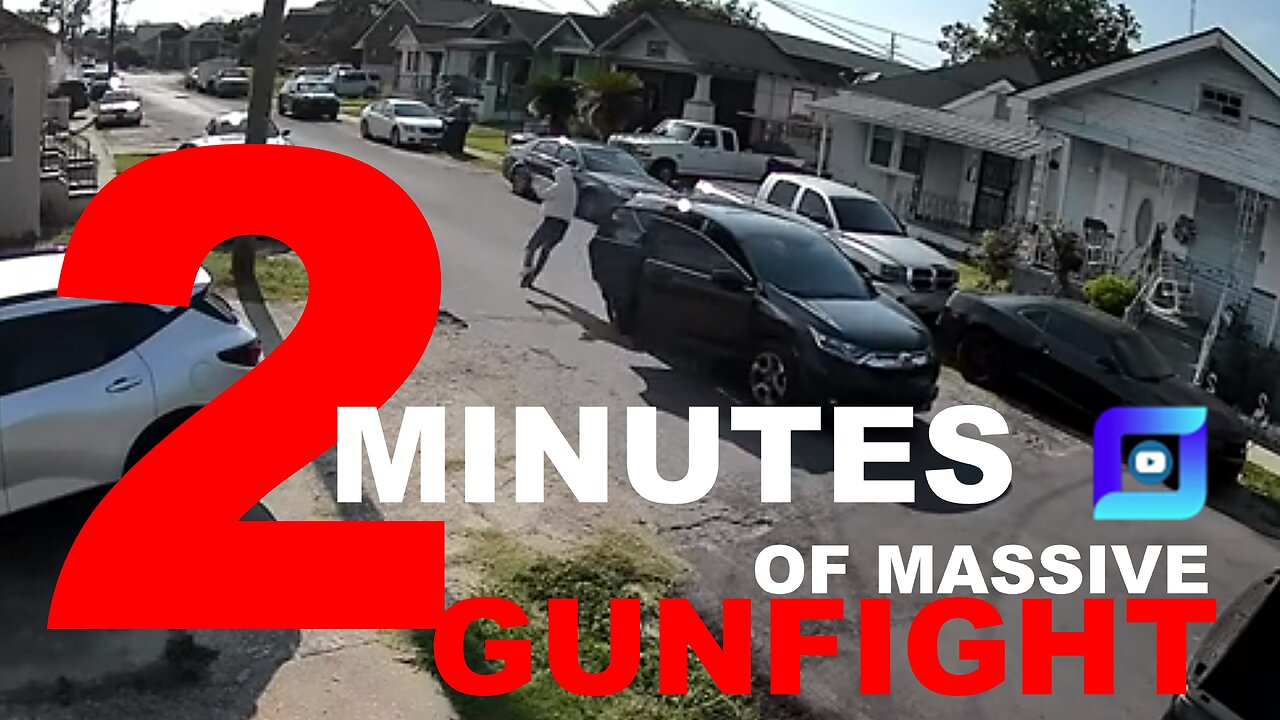Premium Only Content

2 MINUTES OF MASSIVE GUN FIGHT | MUST STOP
Across the United States, communities are grappling with a surge in gang-related violence, leaving residents feeling unsafe and authorities scrambling for effective solutions. This escalating issue demands urgent attention from policymakers and the public alike, as it poses a significant threat to public safety and the overall well-being of society.
The Prevalence of Gang Violence
Gang violence is a complex issue with deep-rooted causes, often stemming from poverty, lack of opportunities, and a sense of marginalization among young individuals. These factors can lead to individuals joining gangs, seeking a sense of belonging and protection, while also engaging in criminal activities to gain power and status.
The consequences of gang violence are far-reaching and devastating. Innocent lives are lost, families are torn apart, and communities are left scarred by fear and trauma. The economic toll is also significant, as healthcare costs, property damage, and lost productivity drain valuable resources.
Statistics Highlighting the Severity of the Issue
To fully grasp the gravity of gang-related violence in the US, consider these alarming statistics from 2023:
Gang-related homicides: According to the FBI's Uniform Crime Reporting (UCR) Program, there were an estimated 3,525 gang-related murders and non-negligent manslaughters in 2023, a 5.6% increase from 2022.
Gang membership: The National Gang Center estimates that there are approximately 75,000 active street gangs in the US, comprising over 800,000 members.
Impact on youth: Gang violence disproportionately affects young people, with nearly 80% of gang-related homicides involving victims under the age of 30.
Government Efforts to Combat Gang Violence
Recognizing the urgency of addressing gang violence, the US government has implemented various strategies to curb its spread and protect communities. These efforts include:
Law enforcement initiatives: Increased police presence in high-crime areas, targeted crackdowns on gang activity, and stricter gun control measures aim to deter and apprehend gang members.
Community-based programs: Prevention and intervention programs focus on providing youth with positive alternatives to gang involvement, such as education, job training, and mentorship opportunities.
Collaborations with social service agencies: Addressing the underlying social and economic factors that contribute to gang involvement requires collaboration between law enforcement, social service agencies, and community organizations.
Gang-related violence remains a pressing issue in the US, demanding a multifaceted approach that combines law enforcement efforts with community-based prevention and intervention strategies. By addressing the root causes of gang involvement and providing positive alternatives for at-risk youth, we can work towards creating safer and more resilient communities.
-
 LIVE
LIVE
Akademiks
1 hour agoDay 3/30. Drake Drops lawsuit vs iHeartMedia? Offset and Cardi Calls it Quits. 50 v Jim Jones?
2,532 watching -
 2:51:55
2:51:55
TimcastIRL
5 hours agoTrump Just FROZE ALL Ukraine Aid After Zelenskyy SCREWED Negotiations w/Viva Frei | Timcast IRL
172K49 -
 9:54:54
9:54:54
Dr Disrespect
14 hours ago🔴LIVE - DR DISRESPECT - PUBG - 5 CHICKEN DINNERS CHALLENGE!
197K26 -
 1:58:28
1:58:28
Kim Iversen
7 hours agoSHOCKED! BETRAYED! RFK Jr. FLIPS on Measles Vaccine? | NATO Trap: Europe Could Drag The US to WW3
86.6K145 -
 18:37
18:37
Clownfish TV
5 hours agoThe Oscars Just EMBARASSED Disney and Emilia Pérez...
47.9K17 -
 56:28
56:28
Glenn Greenwald
7 hours agoDocumentary Exposing Repression in West Bank Wins at Oscars; Free Speech Lawyer Jenin Younes on Double Standards for Israel's Critics | SYSTEM UPDATE #416
95.7K80 -
 1:03:34
1:03:34
Donald Trump Jr.
9 hours agoZelensky Overplays His Hand, More Trump Wins, Plus Interview with Joe Bastardi | Triggered Ep.221
152K121 -
 1:13:16
1:13:16
We Like Shooting
18 hours ago $4.87 earnedDouble Tap 399 (Gun Podcast)
47.5K1 -
 1:00:20
1:00:20
The Tom Renz Show
1 day agoTrump Schools Zelensky, The Epstein Files FAIL, & What RFK Will Mean for Cancer
47.5K18 -
 42:47
42:47
Kimberly Guilfoyle
11 hours agoThe Trump effect: More Major Investment, Plus America First at Home & Abroad. Live w/Ned Ryun & Brett Tolman | Ep. 201
130K43